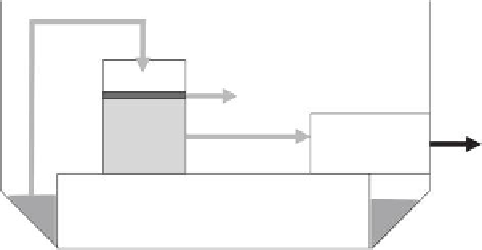Environmental Engineering Reference
In-Depth Information
including steam condensate, boiler blowdown, and sink drainage located in various
machinery spaces, can drain into the bilge. Leaks from the ship's propulsion and auxiliary
systems, as well as precipitation and green water, can also enter the bilge. The presence
of surface-active compounds such as surfactants and polymers leads to complex oil-in-
water emulsions in bilge water that prevent physical separation methods from working
effectively. Emulsion destabilization can be improved by elevating the temperature of the
water, increasing the centrifugal force, or adding chemical demulsiiers. All these mea-
sures signiicantly increase the cost of treatment and in the case of chemical additives can
lead to a new contaminant stream that enters the ocean after oil removal. Flocculation
can also help to break emulsions; however, processes require addition of chemicals and
increasing the pH to alkaline conditions.
12
Current and future regulations have created a need for innovative technology to eco-
nomically separate oil, especially owing to hard-to-treat emulsions found in combination
with mixed contaminants characteristic of many bilge luids. Removal of a wider variety
of dispersed and dissolved chemicals is becoming more of a priority as the toxicity of some
chemical additives and other surface-active compounds are much higher than that of oil. A
variety of nanoengineered membranes and sorbent ilters have been developed to conduct
separations using molecular-level architectures to control the properties of oleophilicity
and hydrophilicity. These materials are reviewed in the context of shipboard water man-
agement, including the economics of deployment in comparison with standard centrifuge-
based oil-water separators.
7.2 Overview of Current Practices
Physical separation methods are most commonly used to meet MARPOL 73/78 guide-
lines. The primary step in treatment is the use of a bilge tank where a majority of the oil
coalesces and can be removed by the phase separation into two layers (Figure 7.2). The free
oil can then be pumped to a holding tank through a strainer to remove larger particles.
Secondary treatment to remove dispersed oil is typically accomplished with either iltra-
tion or, more often, centrifugation to meet the 15 ppm standard. Polymer additives or dis-
solved iron can be added to induce coagulation or locculation; however, such practices are
Primary settling tank
Free oil skimmed
Clean water
overboard
Secondary
treatment
Bilge
well
FIGURE 7.2
General treatment scheme for shipboard bilge water treatment.


